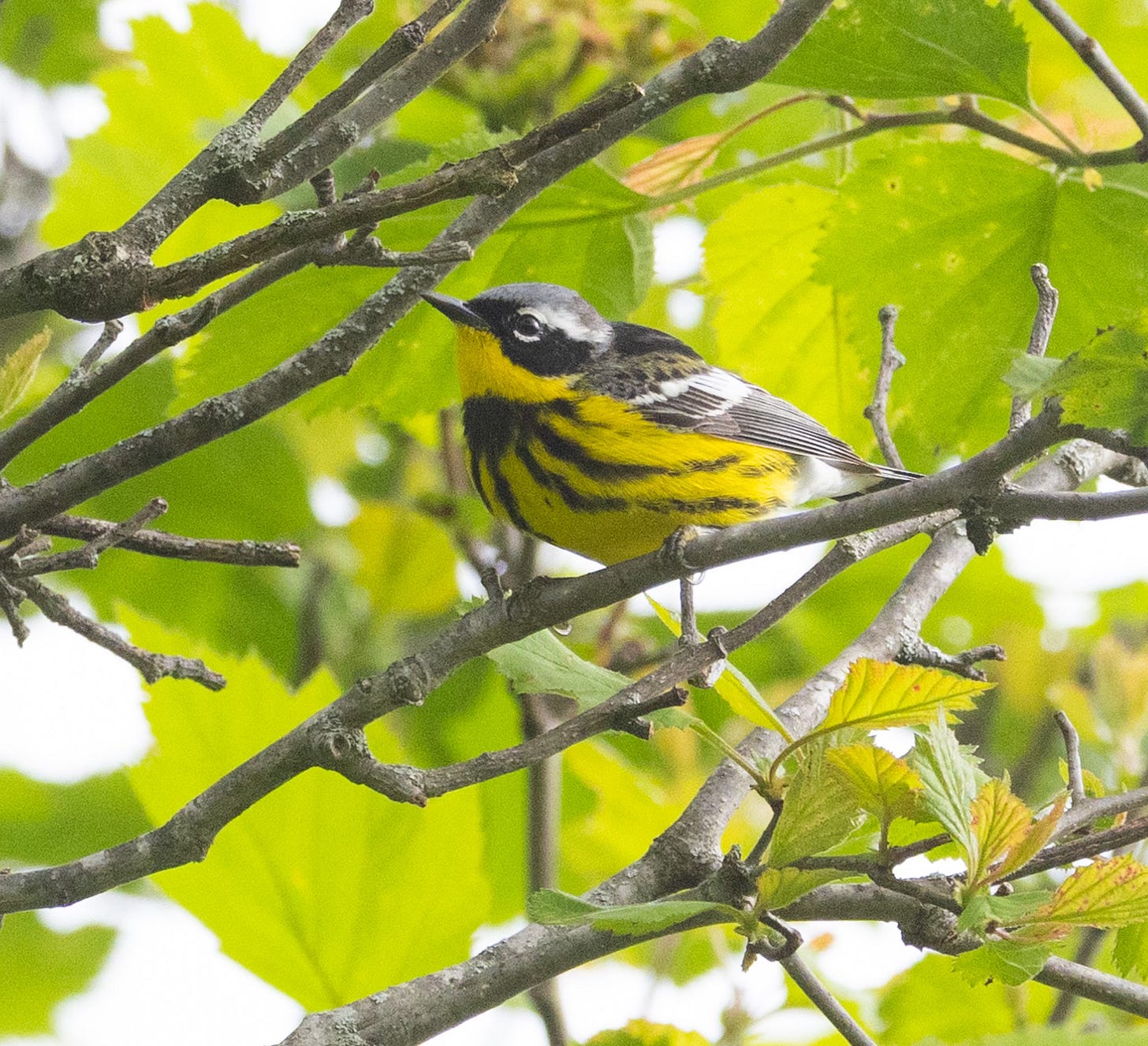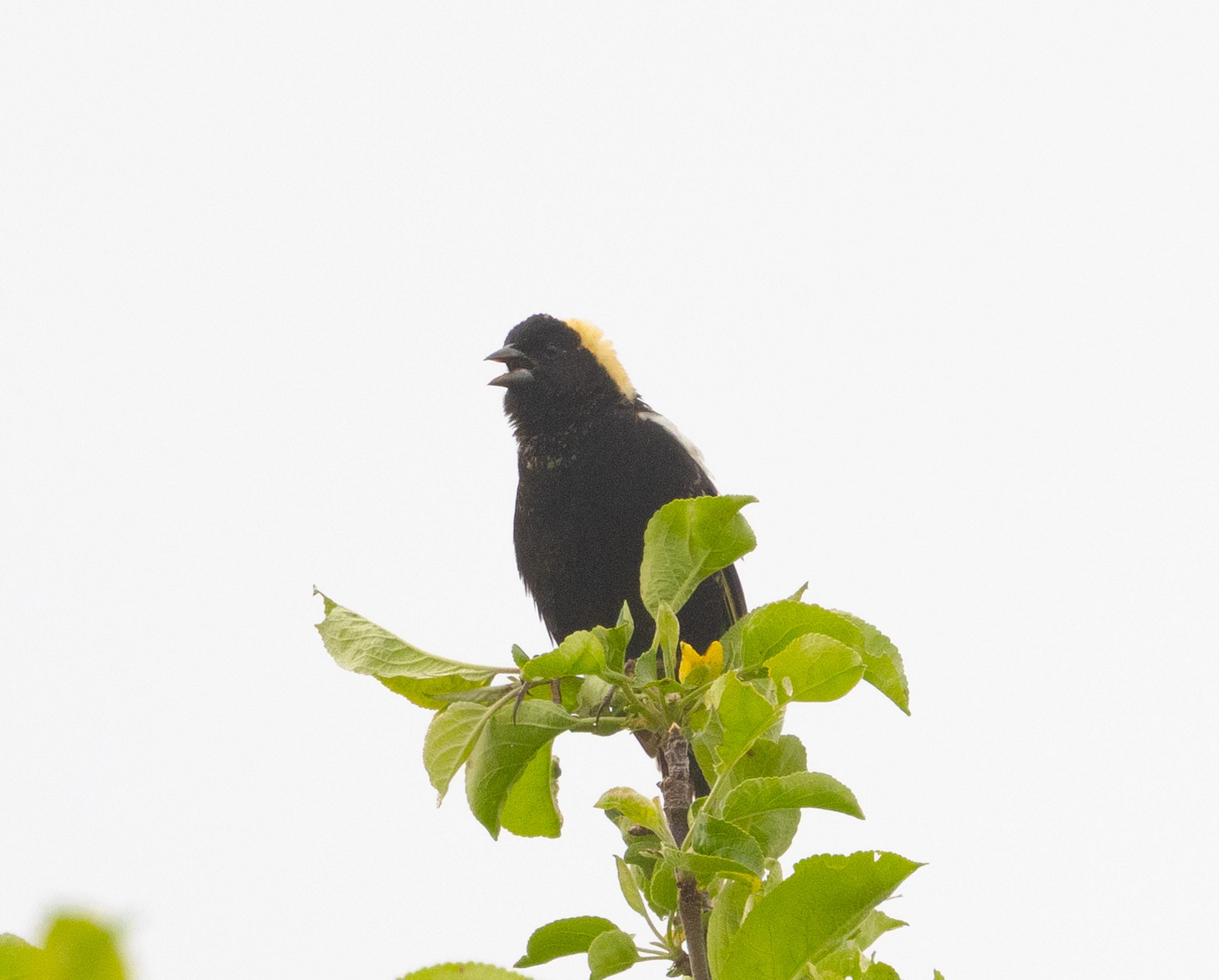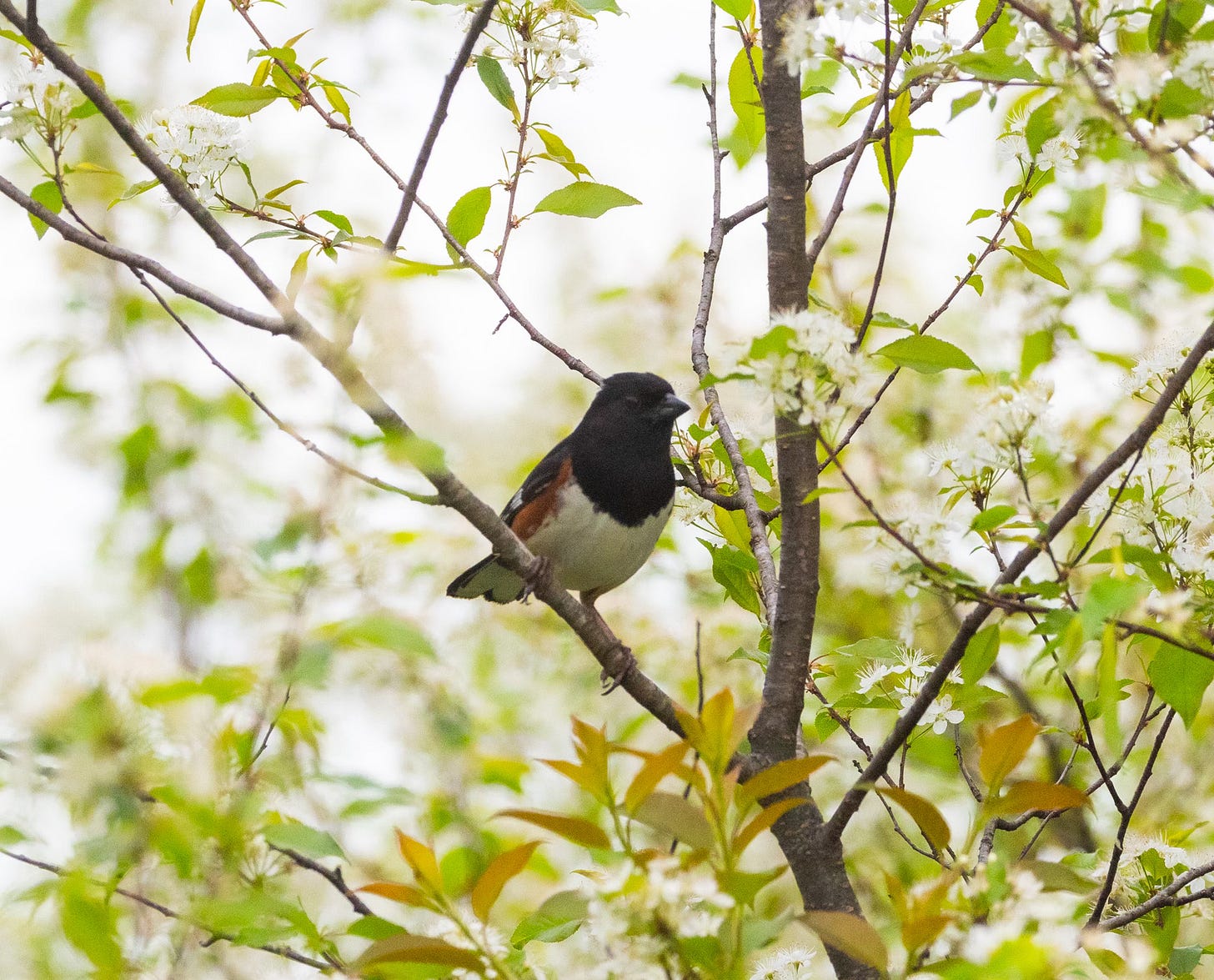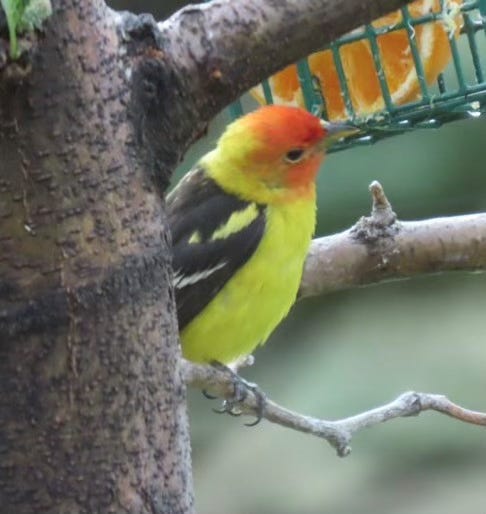1. Let’s begin with a cool video from the Cornell Lab recounting the Lab’s “team” of birders who found 203 species in 22 hours in two spots in Michigan - and also thanking all who made Global Big Day such a huge success: On May 11, 2024, to help celebrate Global Big Day and raise funds for the Cornell Lab’s conservation work, Team Sapsucker headed to the Great Lakes to explore two very different landscapes. One team searched sparsely populated Chippewa County, Michigan, on the shore of Lake Superior; while the other scoured bustling Chicago on Lake Michigan. Energized by the shimmering aurora borealis and the anticipation of watching migration unfold in the heart of North America, the two teams spent nearly 24 hours finding as many bird species as possible. (via All About Birds)
2. Crows have a knack for numbers: Crows can indeed count, according to research published this week in Science. The results show that crows have counting capacities near those of human toddlers who are beginning to develop a knack for numbers, says lead study author Diana Liao, a postdoctoral researcher in neurobiology at the University of Tübingen in Germany. “We think this is the first time this has been shown for any animal species,” she adds. Crows do not appear to be capable of symbolic counting, in which numbers are associated with a particular symbol that serves as an exact representation. This skill is still thought to be unique to humans. Instead the birds are able to count by controlling the number of vocalizations they produce to correspond to associated cues—just like young children who have yet to master symbolic counting often do, Liao says. (via Scientific American)
By Hap Ellis, Magnolia Warbler - Arnold Arboretum, Boston, MA.
3. “Itinerant breeding” - the American Woodcock has it figured out: Conventional wisdom holds that traveling and breeding are two separate phases of a migratory bird’s annual cycle. After all, flying hundreds or even thousands of miles burns an awful lot of energy, as does raising the next generation. To do both at the same time would seem like a recipe for exhaustion. But sometimes evolution surprises us. In fact, scientists have identified around a dozen species—among them the Yellow-billed Cuckoo, Orchard Oriole, and Tricolored Blackbird—whose migratory and reproductive periods they believe overlap. Until now, there was only circumstantial evidence of this exceedingly rare phenomenon, known as itinerant breeding. In a new study, however, a team of researchers has collected what they say is the first concrete proof of itinerant breeding anywhere in the world while tracking the migration of the American Woodcock. (via Audubon)
4. Sadly, another year, another bird listed as endangered: The Committee on the Status of Endangered Wildlife in Canada (COSEWIC) updated the status of twelve Canadian animals this month, and it included the Grey-headed Chickadee among the animals newly considered “endangered." Dr. Louise Blight is the co-chair of the COSEWIC advisory committee on birds. She said Grey-headed Chickadees live at the edge of the treeline in the Pacific Northwest, and were historically common near Old Crow. The bird is so rare that it is hard to estimate its population, she said. She said the reasons for the birds' decline are also unclear. "With many of the species that are assessed, the threats are somewhat clear," Blight said. "It could be something like habitat loss, or an unsustainable harvest on the wintering grounds, but the Grey-headed Chickadee occurs in remote areas without those sorts of human threats. (via CBC)
5. This is interesting - Seabirds helping coral reefs in the Seychelles: Scientists from the Indian Ocean nation of the Seychelles are working to explain how vital seabirds are to the health of coral reefs. Coral reefs are key to the archipelago's economy: on-reef tourism is estimated toearn $51.5 million a year and the Seychelles is one of thehighest fish-consuming countries per capita in the world. But a bleaching event in 1998 decreased live coral cover by up to 97% in some areas and another in 2016 reduced thenational coral coverage by 30%.Camilla Labonte, a Masters by Research student in marine ecology at Lancaster University has recently returned from fieldwork supporting a project focused on reef fish that are commercially valuable for the small-scale fisheries in Seychelles. (via Forbes)
6. The great Margaret Atwood continues to put her shoulder to the birding wheel: Canadian author Margaret Atwood, along with hundreds of avian enthusiasts, migrated to Pelee Island over the Mother’s Day weekend in celebration of birds, books and conservation. The annual Springsong Weekend featured a 24-hour bird race — a competition to see who can spot the most bird species for the Botham Cup — a fundraising dinner and an educational talk by a guest birder. “Bird watching is the most practised participatory sport in North America,” Atwood told the Windsor Star in a phone interview. “A wide range of people do it — from really young people to really old people. What they see and record is very helpful for the people tracking bird species.” Atwood and her late partner Graeme Gibson started the three-day event in 2002 to raise funds for the Pelee Island Heritage Centre with Ron Tiessen, the heritage centre’s director. (via Window Star)
By Hap Ellis, Bobolink - Arnold Arboretum, Boston, MA.
7. Current Biology has a new study on “genetic predispositions” in birds when it comes to learning songs: Genetic predispositions guide population-specific song learning in wild birds, shows new research from Stockholm University. By studying adult pied flycatchers that had been translocated as eggs from the Netherlands to Sweden, the researchers found that the songs of translocated birds resembled both their social environment in Sweden as well as their ancestral Dutch population. These results show how genetic differences can impact cultural change in birdsong and how they can, together, contribute to mating barriers between bird populations. (via Phys Org)
8. Bird news from Iran (yes, Iran): A Garmeh county’s official in charge of tourism, speaking on Thursday, pinpointed that the one-day event, organized in celebration of National Cultural Heritage Week witnessed warm participation from birders. Vahid Mahmoudifar noted that the vibrant tour took place in collaboration with North Khorasan’s Tour Leaders Association. Regarding the location of the birdwatching event, the official stated that Kaftarak Dam, a haven for migratory birds, making it an ideal spot for those seeking a touch of adventure, was a selected area to conduct the tour. This influx of migratory birds has been facilitated by the favorable spring rains, which have created optimal conditions, Mahmoudifar further elaborated. Moreover, the official added that in the wake of recognizing the importance of preserving these habitats, necessary coordination has been established to ensure the continuous monitoring and protection of the wetland ecosystems by environmentalists and wildlife authorities. (via Tehran Times)
9. From Canada - supporting the Conserva Aves Initiative: On May 22, the International Day for Biological Diversity, the Honorable Ahmed Hussen, Minister of International Development, announced an investment of 15 million canadian dollars over 3 years to Birds Canada to support the health of biodiversity and ecosystems in Latin America and the Caribbean through the Conserva Aves Initiative. This contribution will protect migratory birds and their habitats and help achieve the objectives of the Kunming-Montreal Global Biodiversity Framework. Specifically, the investment will enable partnerships to support locally led, and gender-equitable conservation in Latin America and the Caribbean, to create 100 new protected areas totaling at least 2 million hectares. (via Audubon)
10. And then from India - flamingos, commercial airliners, and keeping birds at bay: Bengaluru International Airport Limited (BIAL) has a dedicated department to handle hazardous situations involving birds on the premises. In the wake of dozens of flamingos getting killed while flying over Ghatkopar in Mumbai, Metrolife spoke to BIAL officials about protocols they have in place to avoid such incidents. Bird hits are commonplace but can be critical. The Kempegowda International Airport is surrounded by feeding and roosting sites for many bird species. “Hence, bird sightings are not unusual. Commonly seen birds include black kites, brahminy kites, cormorants, darters, storks, black-shouldered kites, pigeons, lapwings, common coots, egrets, pond herons, small green bee-eaters, Indian robins, and Indian rollers. The species vary with the seasons,” says a BIAL spokesperson. Their Bird Air Strike and Hazard Management department is staffed with experts to deal with incidents such as bird hits. (via Deccan Herald)
By Hap Ellis, Eastern Towhee, Kennebunk Plains, Kennebunk, ME
11. Genome of the “little bush moa” reconstructed - a flightless bird from millions of years ago: A team of evolutionary biologists at Harvard University, working with colleagues from the Max Planck Institute for Biological Intelligence, East Carolina University, Osaka University and the University of Toronto, has reconstructed the genome of an extinct species of flightless bird that has come to be known as the little bush moa. In their study, published in the journal Science Advances, the group sequenced DNA recovered from a fossilized bone found on South Island (the largest and southernmost of the two main islands that make up New Zealand). The little bush moa was once one of the biggest birds in the world—about the size of a modern turkey, they went extinct shortly after the arrival of human settlers in New Zealand. Prior to that, they roamed the forested islands of New Zealand for millions of years. (via Phys Org)
12. Efforts like this help us track the Bald Eagle’s comeback: Bird’s-eye view: On a clear spring morning along the Mississippi coast, Scott Rush, a scientist in Mississippi State University’s Forest and Wildlife Research Center, ascends over an open savannah in a specialized utility bucket truck designed to climb nearly 10 stories high. When he nears the top of the towering pine tree, where a sizable eagle’s nest rests securely in a forked branch, Rush extends a dip net and carefully scoops up one eaglet, then the next, while an adult parent eagle circles anxiously overhead. His work is part of a conservation and environmental stewardship effort, studying the health of the formerly endangered birds that also give indicators of the broader environmental health of their ecosystem. (via Mississippi State University)
13. But then this - who shoots Trumpeter Swan’s, let alone Bald Eagles?: Over the past few years, wildlife rehabilitators in Wisconsin who care for injured birds before releasing them back into the wild started to notice a trend: More and more non-hunted birds were dying. Raptors such as turkey vultures, bald eagles, hawks and owls, and water birds like loons, swans and cranes were showing up to rehabilitation centers with injuries from being shot or otherwise harassed. Concerned about the observed uptick, rehabilitators connected with conservation organization Wisconsin’s Green Fire, or WGF, for help. (via WPR)
By Jennifer Griffis, Western Tanager - Eagle, CO (Jennifer captured one of our prettiest birds).
14. “(M)aping out how birds communicate when in groups”: Nature lovers will know the scene well. A flurry of birdsong, a shake of a tree and out pops a flock of birds flying away in unison together. But how is it that the quick chatter of song among those birds led to that communal flight? A network scientist at Northeastern University in London has been helping experts to shed light on that question by mapping out how birds communicate when in groups. Iacopo Iacopini, an assistant professor in the Network Science Institute, has been working closely with behavioral ecologists to provide "new insights" into vocal communication made by animals. The research has been set out in Iacopini's paper, "Not your private tête-à-tête: leveraging the power of higher-order networks to study animal communication," published May 20 in the journal Philosophical Transactions of the Royal Society B: Biological Sciences. (via Phys Org)
15. Finally a shout-out to the Lazuli Bunting, a beautiful bird and BNI favorite: Texans from the Rio Grande Valley to the Hill Country and into the Panhandle had the unexpected thrill of seeing migrating lazuli buntings in their yards and fields during late April. The name lazuli derives from the stunningly blue mineral, lazurite, or blue stone called lapis lazuli. Seeing the small 5-inch-long lazuli bunting is like catching a glimpse of a radiantly blue gemstone. Bird-watcher Sharron Jay has a feeder outside the kitchen window on her ranch near Comfort. “The day I saw a lazuli bunting feeding alongside a painted bunting and an indigo bunting was a trifecta worth celebrating," she said. (via Houston Chronicle)
Bird Videos of the Week
Video by BBC, “Roadrunner’s Race Against Time”.
Cornell Live Bird Cam - Red-legged Partridge.
Cornell Live Bird Cam - Big Day run in the Great Lakes region.








